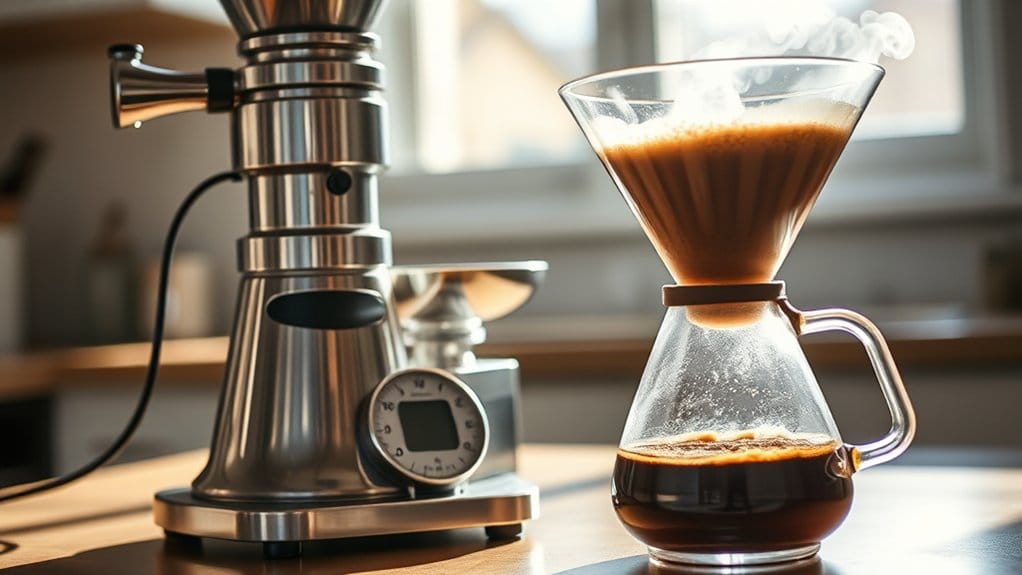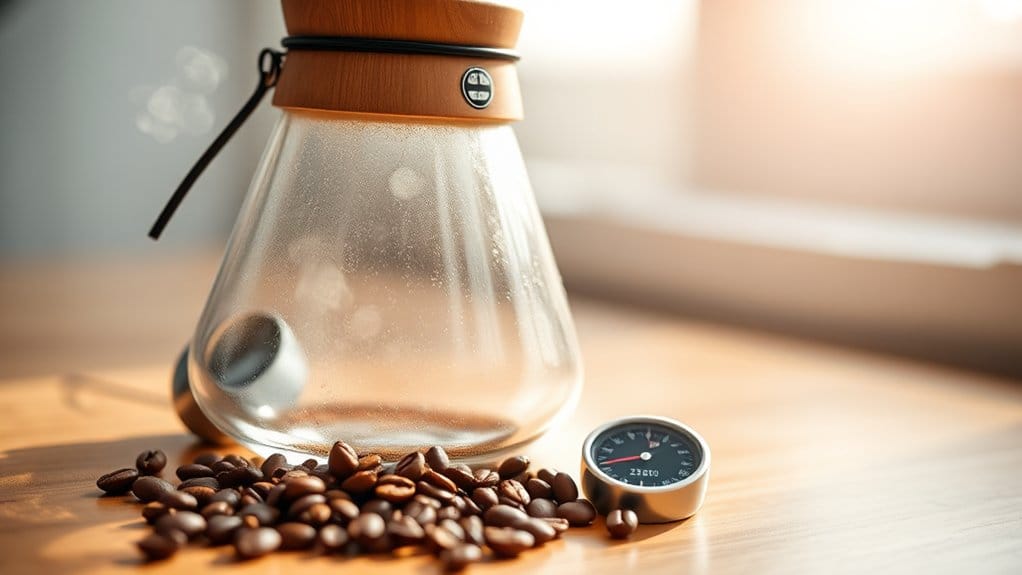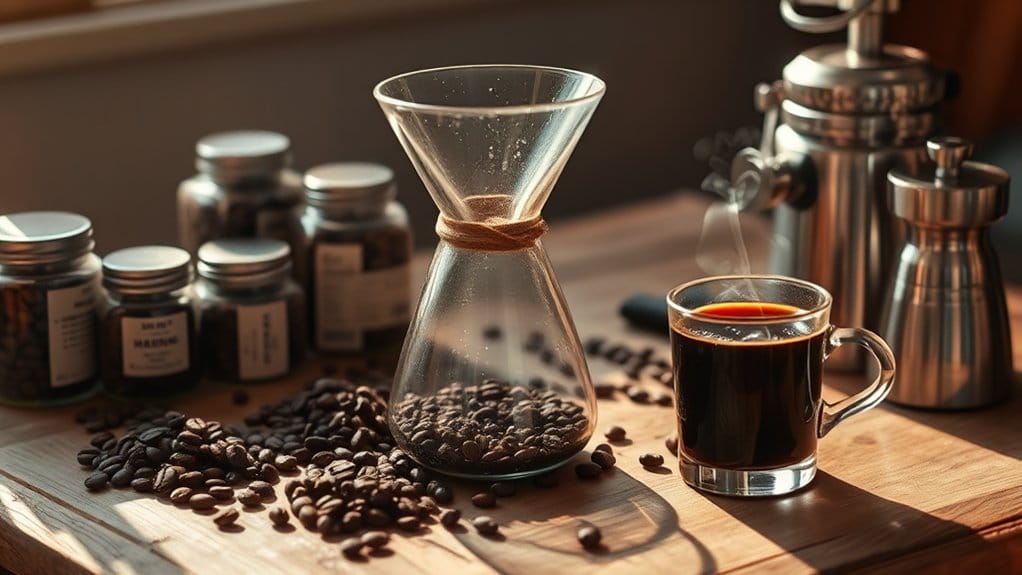Physical Address
304 North Cardinal St.
Dorchester Center, MA 02124
Physical Address
304 North Cardinal St.
Dorchester Center, MA 02124

To brew the perfect Chemex coffee, start with a medium-coarse grind, similar to kosher salt. Adjust your grind based on roast level—darker roasts need coarser grinds, whereas lighter roasts thrive with a finer touch. Master pouring techniques, and don’t forget the blooming step! Use filtered water for best results, and aim for a brewing temperature between 195°F and 205°F. Keep track of your methods to uncover what makes your coffee sing. Want more tips? Keep investigating!

In regards to brewing coffee with a Chemex, understanding the right grind size is crucial—think of it as the foundation of your cup! You want a medium-coarse grind, similar to kosher salt. It should resemble coarse sand, allowing water to flow freely through those thick Chemex filters. If your grind’s too fine, you risk clogging and over-extraction, creating bitter flavors. Too coarse, and your coffee could taste weak or sour. You wouldn’t want that, would you? A consistent grind guarantees even extraction every time, as grinding beans just before brewing ensures the freshest flavor. Additionally, preheating the Chemex with hot water helps maintain optimal brewing temperature, further enhancing your brewing experience even further. Remember, good coffee is like a well-crafted story—it needs the right details. Also, freshly ground coffee maximizes flavor extraction, enhancing your brewing experience even further.
Roast level plays a key role in how you adjust your grind size for that perfect Chemex brew.
Darker roasts are like soft marshmallows, needing a coarser grind to avoid bitter vibes, whereas lighter roasts resemble sturdy rocks, requiring a finer grind to release their bright flavors. When you grind dark beans too fine, watch out! You’ll get a cup that tastes burnt and harsh. Aim for coarser settings to keep it smooth and sweet. Additionally, it’s essential to remember that grind size can significantly affect coffee flavor extraction, so adjusting it properly is crucial for an optimal brew. This is especially true for light roasts, which require a finer grind size for proper flavor extraction to highlight their vibrant characteristics. Moreover, using the golden ratio of coffee to water helps ensure a balanced extraction, maximizing the potential of your beans.
Conversely, a light roast needs those fine particles for complex, delicious notes. So remember, just like Goldilocks, you want your grind to be just right—coarse for dark, fine for light.
You’re already on your way to brewing coffee magic!

When you’re pouring water over your Chemex grounds, think of it as a movement between you and the coffee.
Use the pulse pouring method, pouring about 200 grams at a time, lasting around 30 seconds. Give it a little break for about 30 seconds too. This way, you saturate the coffee properly and let it bloom. Aim to finish at around 700 grams, within 3 to 3.5 minutes. Consistent pouring helps avoid those annoying dry spots and keeps the flavors balanced. The Chemex paper filter effectively removes sediment and oils, ensuring a cleaner cup. So, don’t rush!
Freshness of coffee affects taste, so always choose high-quality beans for your brewing. Feel free to experiment with larger initial pours or a light agitation post-pour. It’s all about finding that sweet spot for a cup that makes you smile—after all, it’s coffee time!
Brewing a great cup of coffee isn’t just about the beans and your pour-over skills. It’s furthermore about the quality of water you use.
You see, water acts like an unsung hero, extracting all those lovely flavors from your coffee grounds. Hard water can give a stronger brew, but too much calcium or bicarbonate might make it bitter. On the flip side, soft water can mute those rich coffee notes, leaving you with a flat experience.
Ideally, you want a balanced mineral content, like Goldilocks found with her porridge—not too hard, not too soft. So, experiment a bit! Tap into local water sources or use filtered options for the best brews.
Given that climate change impacts coffee quality, using the right water can help enhance the flavors and contribute to a better cup.
Your taste buds will thank you!

Finding the right brewing temperature for your Chemex might feel like a science experiment, but it doesn’t have to be complicated! Aim for a range between 195°F to 205°F, with 200°F being the sweet spot.
If you pour boiling water directly, you might end up with a bitter brew that tastes more like an unhappy accident than a delightful cup of coffee. Give your water about 30 seconds to cool after boiling—it’s like letting it take a breather!
Preheating your Chemex is a transformative element too. It keeps the brew temperature steady, balancing flavors beautifully.
Ready to improve your coffee game? Finding the right coffee-to-water ratio is your secret weapon.
Start with a 1:15 ratio—one gram of coffee for every 15 grams of water. This ratio balances flavor nicely, giving you a rich, satisfying cup. If you want a crisper taste, try 1:16; if you prefer something smoother, 1:17 works wonders.
Don’t have a scale handy? No problem! Use two level tablespoons of coffee for every six ounces of water.
For one cup—about eight ounces—use around 25 to 28 grams of coffee. Remember, maintaining water temperature around 200°F is also essential for optimal extraction and flavor.

Blooming, as it may sound like a gardening term, is actually a vital player in making your coffee shine.
When you pour hot water on your grounds before brewing, you let trapped carbon dioxide escape. This little step prevents uneven extraction, which means your coffee won’t taste weak or bitter.
Proper blooming amplifies the sweet, floral, and chocolatey notes in your cup, leading to a smoother mouthfeel. You want a balanced flavor, right?
Skipping this step can leave you with sour or muted coffee, and who wants that? So, when you brew your Chemex, take about 30-45 seconds for blooming.
Additionally, using freshly ground coffee ensures superior flavor as it retains the coffee’s aromatic qualities.
Trust me, your taste buds will thank you for this simple yet important coffee ritual!
Though it might seem like a small detail, preventing channeling during brewing can make a huge difference in your coffee experience.
Start with even ground coffee distribution. Use methods like the Stockfleth technique to avoid gaps in your filter. Overfilling? That’s a no-go; keep it to 14-15 grams for easier tamps.
Next, verify your grind size is consistent—coarser grinds are your friend. Remember, no one wants swimmies in their coffee!
Tamping lightly helps maintain an even coffee bed, keeping water flow smooth. Finally, pour slowly in a gentle circle to saturate grounds evenly. Treat your Chemex like a delicate ballet partner!

When you’re brewing with a Chemex, experimenting with grind and brew variables can be a bit like playing in your own coffee laboratory.
Start with a medium-coarse grind, about the size of kosher salt, and a 1:17 coffee-to-water ratio. If your brew tastes weak or under-extracted, go finer. If it’s bitter, try a coarser grind. Adjusting these factors can create a whole new experience!
Remember, pour your water in a slow, circular motion, spreading the love evenly across the coffee grounds. This technique mimics precision pouring, ensuring an even extraction throughout the brew.
And hey, don’t forget about brew time—aim for 4 to 5 minutes. It’s all about finding that sweet spot that makes your taste buds sing. Enjoy the process; after all, who doesn’t love a little coffee science?
Keeping detailed brewing notes can transform your coffee experience from just a morning routine into a delightful adventure. Think of your notes as a treasure map leading to your perfect cup.
When you record details like grind size, dose, and brew time, you can pinpoint what brings out those lovely flavors. Tracking coffee source and roast date helps you understand how freshness affects taste. You wouldn’t want last week’s coffee in today’s cup!
Whether you use a notebook or an app, being consistent in your note-taking makes all the difference. Plus, your future self will thank you for the clear insights.
In the world of coffee, knowledge is certainly power (and delicious!). So, start jotting down those brews!
You can use flavored coffee beans with Chemex, but they might affect the brew’s clarity and brightness. It’s best to test small batches and adjust grind size for ideal extraction and flavor balance.
After brewing, rinse your Chemex immediately with cold water to remove grounds and oils. For deeper cleaning, use ice, salt, and soap, or a vinegar solution, ensuring to rinse thoroughly to prevent residue buildup.
Chemex filters are made from heavy, laboratory-grade paper crafted from virgin pine wood pulp. These oxygen-cleansed filters are designed to remove fats and sediments, ensuring you get a pure and flavorful coffee experience every time.
You can make cold brew with a Chemex, but it’s easier to use for flash brew iced coffee. Just keep in mind that traditional cold brew requires longer steeping times and different equipment for the best results.
You can store brewed Chemex coffee in the refrigerator for up to 24 hours. It stays fresher this way, but after that, flavors start to degrade and bitterness increases. Enjoy it as long as it’s still ideal!